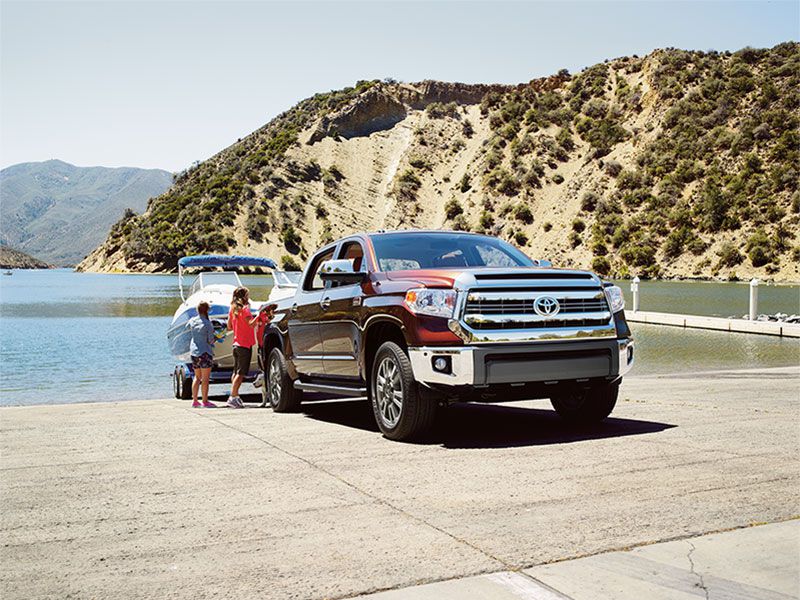Recent Articles
Popular Makes
Body Types
2017 Toyota Tundra Road Test and Review
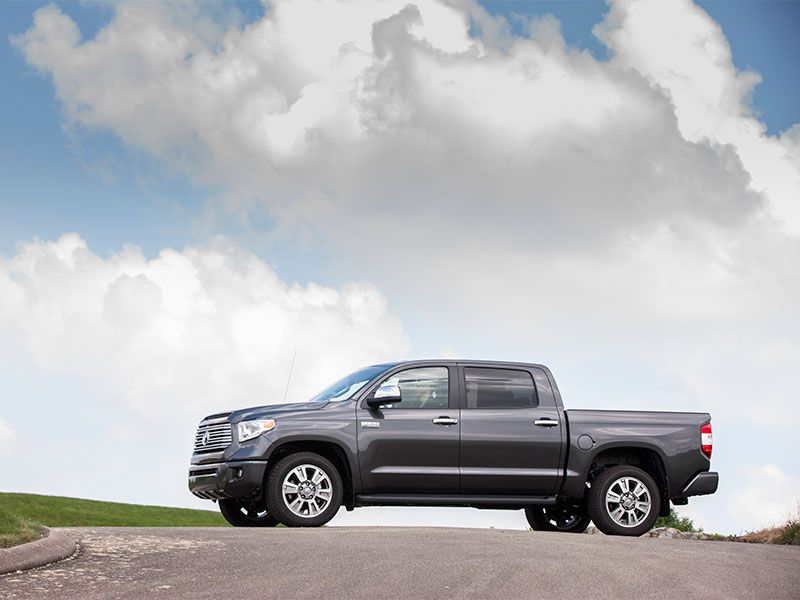
2017 Toyota Tundra Platinum exterior profile ・ Photo by Toyota
Tastes change. Markets ebb and flow. Things die. But not when it comes to America’s love affair with full-size pickup trucks. This love springs eternal.
Americans continue to buy large pickups at record rates, and the automakers competing in the segment are cashing in. But they’re also investing in the space, designing, engineering, and building the most powerful, most technically advanced and most capable pickup trucks the world has ever seen.
Now in its second generation, the 2017 Toyota Tundra brings the power, comfort, and capability full-size truck buyers demand. Built exclusively in San Antonio, Texas, Tundras can be found putting in the hours at job sites, campgrounds and surf spots all over America.
Let's take a closer look at the 2017 Toyota Tundra.
Models and Pricing
Toyota offers the Tundra in a wide range of configurations. Three body styles are offered: Regular Cab, Double Cab, and the big boy CrewMax with four conventional doors and a backseat the size of west Texas.
They’re available with 2- or 4-wheel drive and in six distinct trim levels: SR, SR5, Limited, the luxuriously appointed Platinum, the 1794 Edition, and the off-road-focused TRD Pro. Prices start at $30,500 for a 2-wheel-drive Regular Cab SR and max out at $50,130 for a CrewMax 1794 Edition with 4-wheel drive. The base price of the CrewMax TRD Pro Autobytel tested was $46,110.
Unlike the big trucks offered by Ford, Chevy, GMC, and Ram, Toyota only builds half-ton Tundras powered by gasoline engines. There is no heavy-duty three-quarter-ton or one-ton variety, and no diesel engines available.
There are no V6 engines either. Two engines are available, both double-overhead-cam V8s backed by a 6-speed automatic transmission.

1794 and TRD Pro?
Toyota’s two top-of-the-line Tundras wear some weird names, 1794 Edition and TRD Pro. Why?
The first is named for the sprawling ranch founded in 1794 on the land where Toyota’s Tundra assembly plant now sits. It’s available only in the CrewMax body styles with the larger 5.7-liter V8 in 2- or 4-wheel drive, and it features saddle brown leather on its seats, with suede accents.
It comes loaded with LED daytime running lights, 12-way power driver’s seat with memory and a 4-way power passenger’s seat (both with heat and ventilation), a 12-speaker touchscreen Entune Premium JBL Audio system with Navigation, power sunroof, Blind-Spot Monitor with Rear Cross-Traffic Alert and front and rear parking sonar and an auto-dimming rearview mirror. Options are limited to running boards and 20-inch chrome wheels with larger tires.
Named for Toyota Racing Development, the TRD Pro takes the Tundra’s off-road capability to its highest levels, over and above the TRD 4X4 package. It’s available in Double Cab and Crew Max models, and every TRD Pro is 4-wheel drive and powered by the larger 5.7-liter V8 that growls through a special TRD dual exhaust.
Suspension upgrades increase wheel travel at all four corners, and TRD-tuned Bilstein shocks work with 18-inch TRD black alloy wheels wrapped in all-terrain tires. Plus there’s an aluminum skid plate. These upgrades make the Tundra TRD Pro one of the most capable off-road trucks.
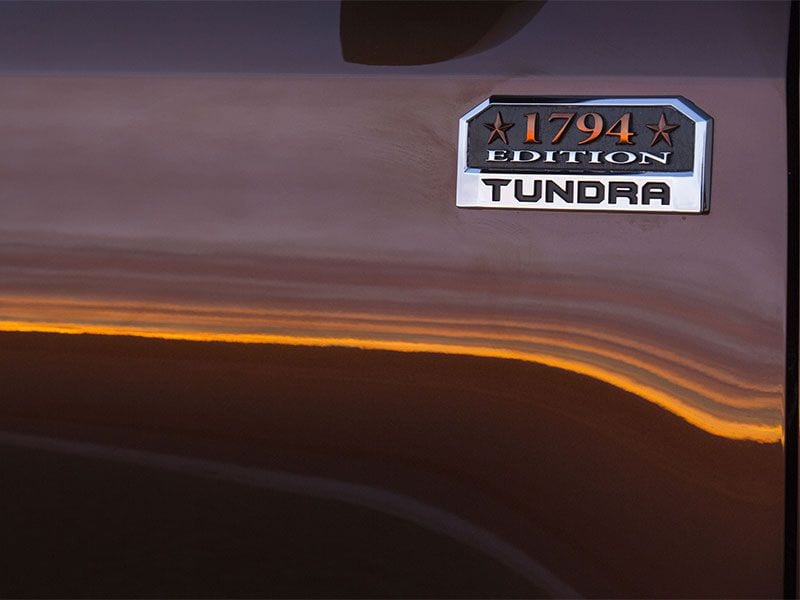
V8 Power and Fuel Economy
Tundras are powered by one of two gasoline V8s. The first is a 4.7-liter that produces 310 horsepower at 5,600 rpm and 327 lb.-ft. of torque at 3,400 rpm. Its fuel economy isn’t very impressive either. It’s rated at 15 mpg city/19 mpg highway in 2-wheel-drive models and 14 mpg city/18 mpg highway with 4wd.
The larger and more powerful 5.7-iter V8 makes 381 hp at 5,600 rpm and 401 lb.-ft. of torque at 3,600 rpm. Its fuel economy is also unimpressive. It’s rated at 13/18 mpg with 2wd, or 13/17 with 4wd. These numbers are certainly sabotaged by the Toyota’s prehistoric 6-speed automatic transmission. Most other trucks in the class now feature transmissions with 7 or 8 speeds and Ford just introduced a 10-speed automatic in its F-150.
The good news: Both engines run on 87-octane regular grade fuel and some models get a 38-gallon fuel tank that gives the Tundra copious amounts of range, which is a must for towing.
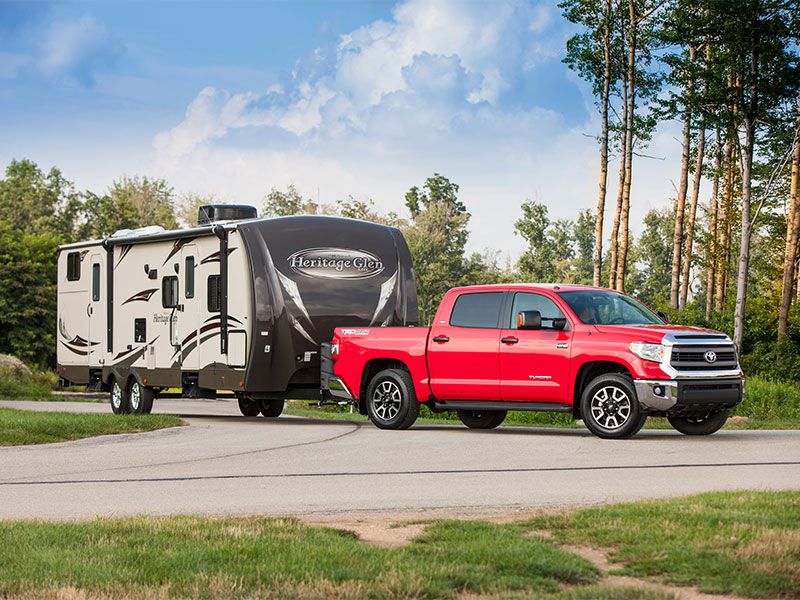
Unexciting Exterior Design
Unattractive? Not really. Frumpy? Maybe a little. Sexy? Far from it. The exterior design of the 2017 Toyota Tundra doesn’t really turn us on or make us retch. It’s sort of like the Camry of fullsize trucks, handsome enough, but generally conservative and maybe a bit too generic.
This is in contrast with its smaller brother, the aggressively styled and fast selling Toyota Tacoma, which is very attractive and goes about its business with an unmistakable masculine swagger that the dirtbikes and beer crowd gravitate toward.
The Tundra’s conservative design lacks that kind of attitude. And the result is a bit bland. It’s a yawner. Uninspired. Fullsize trucks from Ford, Chevy, GMC, Ram and Nissan are far more interesting to look at.
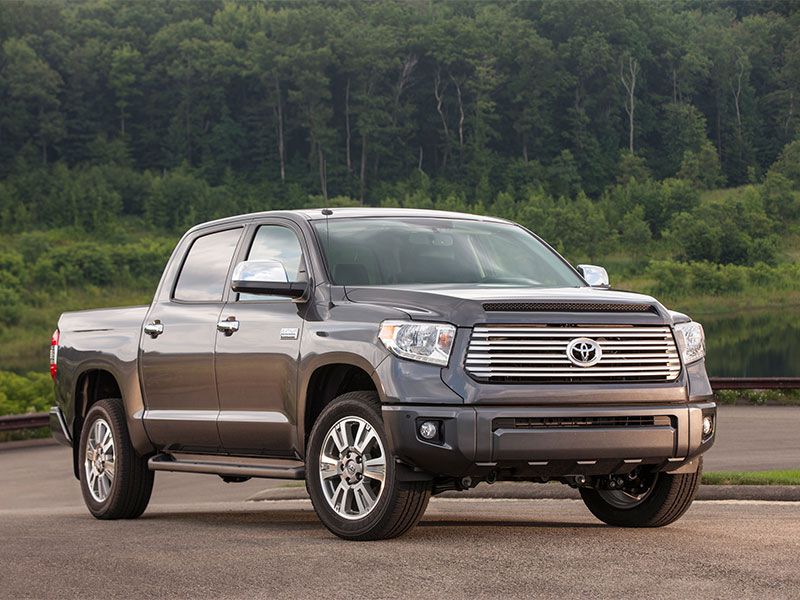
Inside the Tundra
Much like the Tundra’s exterior, its interior doesn’t really take any risks or break new ground in the fullsize truck genre. It’s well assembled, properly ergonomic and perfectly functional, but it’s also a bit boring.
The gauges are clear and simple, if a bit common, and there’s a nicely presented center-mounted screen for additional information. The dash’s knobs are large, as are the cupholders, and the center console bin is humongous. Double Cab and CrewMax models are available with bench or bucket seats in front, and rear seats in both cab styles can be folded up for additional cargo. When a bench seat is specified, the shifter moves from the console to the steering column.
All Tundras come with standard Bluetooth. Toyota’s Entune system with navigation, as found on our TRD Pro test truck, is packed with capability and the touchscreen keeps things simple. Another cool and unique feature is the Tundra’s back window, which retracts down like it's side glass. No other truck has this and it’s great on sunny days or when you need quick access to something in the bed.
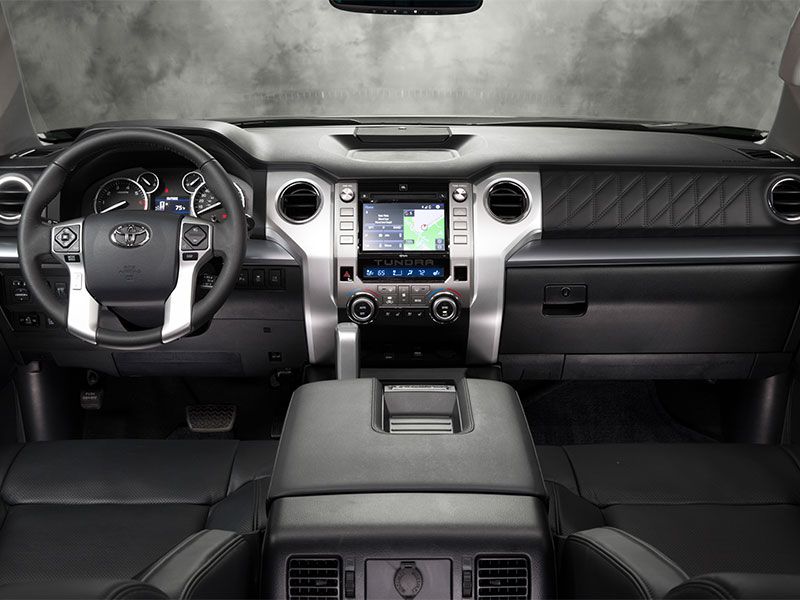
How it Drives
The 2017 Toyota Tundra is a very comfortable truck. The seats are large and well shaped, and the seating position is perfect. Despite its off-road-tuned suspension, our TRD Pro test vehicle rode well in town and out on the highway. Not as well as a Ram, which uses a unique coil spring rear suspension, but the Tundra doesn’t beat you up or feel overly trucky.
And it’s fast. The 5.7-liter V8 and 6-speed automatic aren’t exactly state of the art, but there’s plenty of power and it’s fun to put your foot down and listen to that big rumbly V8, although the TRD exhaust can drone at highway speeds.
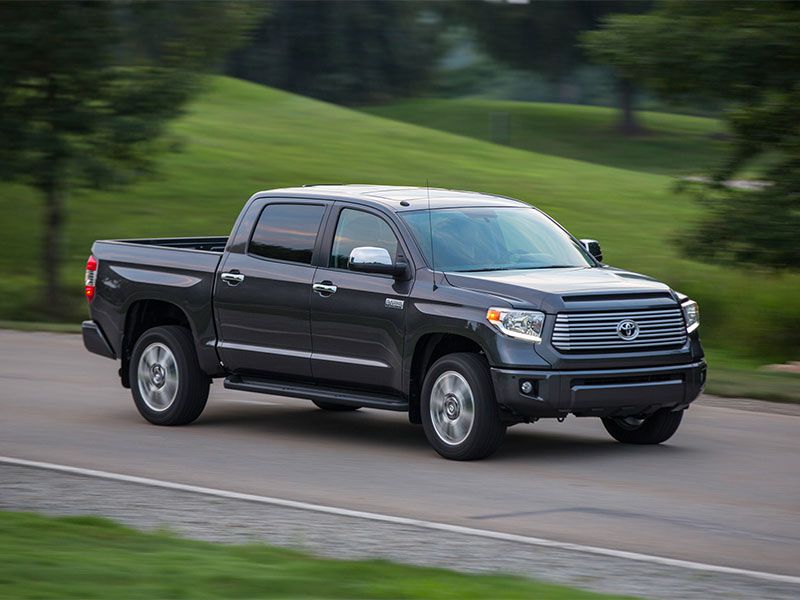
Cargo and Towing
The Tundra Regular Cab comes with an 8.1-foot bed, Double Cabs have a 6.5-foot bed, and the bed on CrewMax models measures 5.5 feet. All Tundra beds are 22.2 inches deep and payload capacity maxes out at 2,080 pounds, depending on how the truck is equipped. There’s also an available deck rail system, which helps tie down cargo, and a spray-in bed liner.
With its standard Tow Hitch Receiver and Tow Package, which is available on all models, the 5.7-liter V8 Tundra offers a maximum tow capacity of up to 10,500 pounds (4x2 Regular Cab). The Tow Package adds engine and transmission oil coolers, a heavy duty battery and alternator, a 7- and 4-pin towing hitch and a TOW/HAUL mode adjusts throttle sensitivity and transmission shift points for better control. The Tundra also comes with an integrated Trailer Brake Controller.
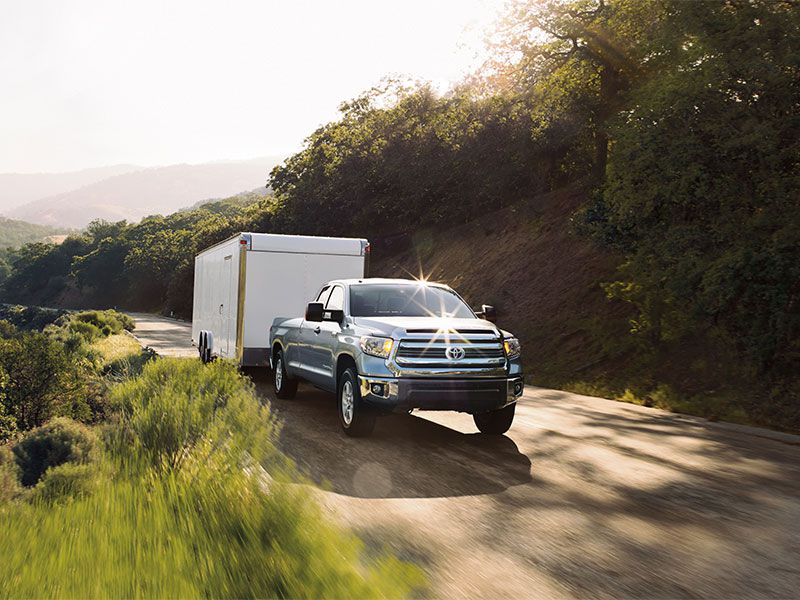
The Competition
The Toyota Tundra competes directly with the Ford F-150, Chevy Silverado, GMC Sierra, RAM 1500 and the Nissan Titan. It outsells only the Nissan. And it’s a distant fifth place behind the GMC.
Fullsize truck buyers are extremely brand loyal, and the many decades of consistent and sizable investment Ford, GM and Ram have made in their trucks has created some very desirable and capable vehicles. The Tundra is struggling to keep up, and an all-new Nissan Titan is beginning to nip at its heels. Plus the Nissan’s warranty is the best in the segment.
The Tundra, however, stands strong with unique features, a long-standing reputation for durability and reliability and high resale values.
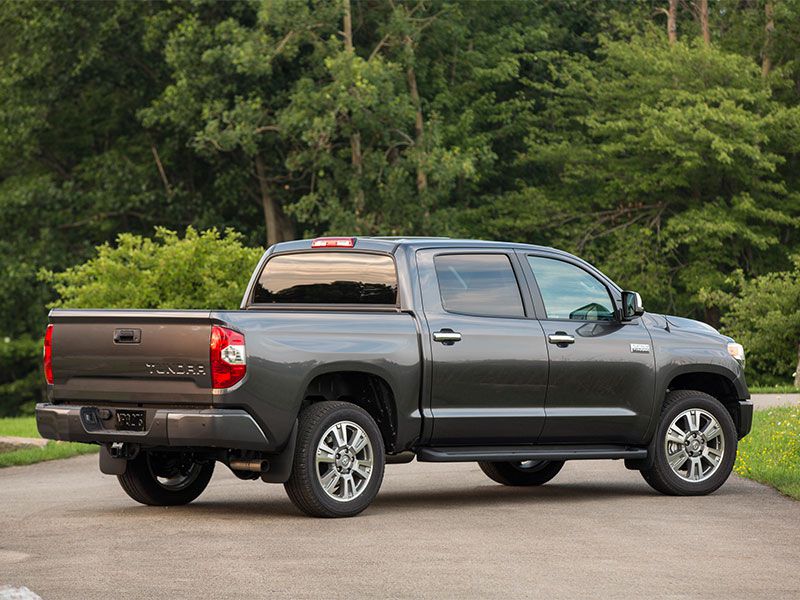
Final Thoughts
For those in the market for a big pickup, the 2017 Toyota Tundra is a solid overall choice. With so many body styles and trim levels to choose from, there’s bound to be a Tundra that fits your wants, as well as your needs, from a bare bones work truck to an off-road plaything.
Although we found its design to be a little uninspired compared to its competition, and its powertrains aren’t the most fuel efficient, the 2017 Toyota Tundra is a very likable, extremely comfortable, and highly capable truck.
